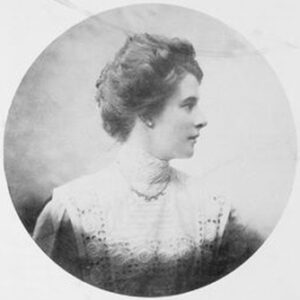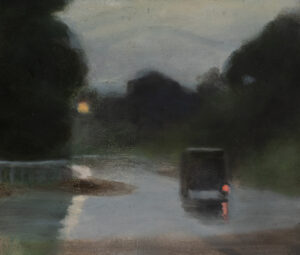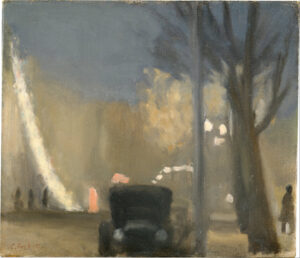2. Clarice Beckett
One of the Hotel’s features is our rooms are named after Australian artists. Room 2, one of our queen ensuite rooms, is named after Clarice [Clara] Beckett.



Middle Image: Painting in Castlemaine Art Museum ‘Wet Evening’ by Clarice Becket, 1927
Clarice Beckett (21 March 1887 – 7 July 1935) was an Australian artist and a key member of the Australian tonalist movement. Known for her subtle, misty landscapes of Melbourne and its suburbs, Beckett developed a personal style that helped give rise to modernism in Australia. Disregarded by the art establishment during her lifetime, and largely forgotten in the decades after her death, she is now considered one of Australia’s greatest artists.
Born and raised in the country town of Casterton, Victoria, Beckett was seen as extremely shy from a young age, as well as bright and artistic. In 1914, after moving to Melbourne with her family, she began a three-year study at the National Gallery School under Australian impressionist painter Frederick McCubbin, then for nine months attended the rival school of art theorist Max Meldrum, a controversial outlier of the Australian art world who propounded his own tonalist painting system drawn from scientific principles. Beckett and others in Meldrum’s circle, derided as “Meldrumites” by his critics, began staging group exhibitions in 1919. Beckett also exhibited with the Meldrum-inspired Twenty Melbourne Painters Society, and staged the first of her annual solo exhibitions in 1923.
Beckett never left Victoria and rarely traveled outside Melbourne, much of her adult life being spent caring for her ailing parents at their home in bayside Beaumaris. She did however paint prolifically, often en plein air in and around Beaumaris, and mostly at daybreak or towards evening, when she was exempted from domestic duties. In her method and choice of “everyday” subject matter, Beckett remained indebted to Meldrum, but her work also differed from that of other tonalists, in part due to its emotional and spiritual qualities, reflecting her interest in Buddhism, Theosophy and Freud.
By 1926, she was creating landscapes unprecedented in Australian art for their “radical simplicity”, and from 1930, she experimented further with a broader colour palette and more challenging compositions. In 1935, while painting the sea off Beaumaris during a winter storm, Beckett contracted pneumonia and died four days later, aged 48. [Source Wikipedia]
LINK: Room Brochure
